A-10 Thunderbolt II
|
|
The A-10/OA-10 Thunderbolt II, often known as the "Warthog," is the first US Air Force aircraft specifically designed for close air support of ground forces. It is a simple, effective and survivable single-seat, twin-engine jet aircraft designed to attack ground targets, including tanks and other armored vehicles.
| Contents |
Description
The A-10/OA-10 have excellent maneuverability at low air speeds and altitude. They can loiter near battle areas for extended periods of time and operate under 1,000 foot (300 m) ceilings with 1.5 mile (2.4 km) visibility. The aircraft's wide, straight wings allow short takeoff and landing capability, permitting operations in and out of locations near front lines and excellent low-speed maneuverability. It is able to fly at a relatively slow speed of 200 mph (320 km/h), which gives it an advantage in the ground-attack role, where fast fighter-bombers often have difficulty pursuing small and slow-moving ground targets.
The 'Warthog' is designed to be exceptionally robust, with a strong airframe and the ability to survive considerable battle damage. The aircraft can survive direct hits from armor-piercing and high-explosive projectiles up to 23 mm. Manual systems back up their redundant hydraulic flight-control systems. This permits pilots to fly and land when hydraulic power or part of a wing is lost. The self-sealing fuel cells are protected by fire-retardant foam to prevent fire and explosion. The cockpit is protected by 900 pounds (400 kg) of titanium armor (referred to as a "titanium bathtub") that also protects parts of the flight-control system. Additionally, the placement of the engines is such that exhaust passes over the aircraft's vertical stabilizers, decreasing the A-10's infrared signature and decreasing the likelihood that the aircraft can be "acquired" or locked on to by IR sensing surface to air missiles. The placement of the engines also ensures that they are almost always shielded from below by either the wings or the tail unit, making a strike to either engine from Anti-aircraft warfare or AAA less likely. Even if one of the podded engines is totally destroyed or detached from the airframe, the A-10 is still capable of flight.
The Thunderbolt II can be serviced and operated from bases with limited facilities near battle areas. An unusual feature is that many of the aircraft's parts are interchangeable left to right, including the engines, main landing gear, and vertical stabilizers. An inbuilt ladder allows the pilot to enter or exit the aircraft without needing external assistance. The sturdy landing gear with low pressure tires and large, straight wings allow operation from short rough strips even with a modest weapon load. The aircraft is designed to be re-fueled, re-armed and serviced with minimal equipment. Operating from a forward area is both useful from a close air support point of view and necessary due to its relatively low cruise and top speeds. It also allows disperal to reduce the damage from an attack on airbases or for the aircraft to operate from a damaged airbase that most other aircraft would be unable to use.
The A-10 has been criticized for its minimal avionics fit. It was originally intended purely for close air support, for which it was felt that complex electronics would be unnecessary (and would have an undesirable effect on serviceability and cost). Initial fit provided basic communications, a radar-warning system, and TACAN navigation, early aircraft lacking even an autopilot. As USAF emphasis shifted towards the anti-armor role, presumably in a conflict with the Warsaw Pact in Western Europe, where weather is frequently poor, there was pressure for improved sensors and electronics. Fairchild-Republic offered a two-seat NAW (Night and Adverse Weather) variant beginning in 1977, but it was not adopted. Aircraft were eventually upgraded with inertial navigation and a Pave Penny laser sensor (marked target seeker) pod that allowed the pilot to direct laser-guided bombs against targets marked by friendly forces. The A-10 initially lacked any weapons delivery systems for rangefinding or the computation of impact points, greatly limiting its ability to deliver weapons other than cannon and rocket fire (in direct, visual-range attacks) or the self-guided AGM-65 Maverick missile, whose own sensors displayed imagery in the A-10's cockpit. Much later in the 'Warthog's' career, the Low-Altitude Safety and Targeting Enhancement (LASTE) upgrade finally provided computerized weapon-aiming equipment, an autopilot, and ground-collision warning system. The A-10 is now compatible with night-vision goggles for low-light operation. From 1999 surviving aircraft are being upgraded with GPS for improved navigation.
Although the A-10 can carry a considerable weight of disposable stores, its primary built-in weapon is the 30 mm GAU-8/A Gatling gun. The most powerful aircraft cannon ever flown, it fires large, depleted uranium armor-piercing shells at a rate of 3,900 rounds per minute. The massive shells and high muzzle velocity allow the Avenger to engage heavily armored main battle tanks. The chasis of the plane is actually built around the gatling gun. This gun is said to produce almost the same amount of force as one of the A-10's engines, leading to a persistent military legend that if enough bullets could be carried and fired in a long burst, the plane would stop flying (or move backwards, in some versions of the legend).
Using the specs from the GAU-8/A product homepage (http://www.gdatp.com/products/lethality/gau-8a/gau-8.htm),the recoil force of the GAU-8/A is measured to an average of 10,000 lbf (45 kN). This is more than 50% of the thrust of both of the A-10 engines at full power which is indeed a considerable amount. However that still leaves almost half of maximum available forward thrust. The A-10 will certainly continue flying forward, even when firing the gun continuously for long periods of time.
Despite the power of the GAU-8, the principal weapon of the A-10 is the AGM-65 Maverick air-to-surface missile, with electro-optical targeting. The Maverick allows targets to be engaged at much greater ranges than the cannon, a safer proposition in the face of modern anti-aircraft systems. Other weapons include cluster bombs and rocket pods. Although the A-10 is equipped to deliver conventional and laser-guided bombs, their use is relatively uncommon. For self-defense, A-10s usually fly with an ECM pod under one wing and two AIM-9 Sidewinder air-to-air missiles under the other.
A-10_Thunderbolt_flight.jpg
Operational Service
In the eyes of Air Force brass, A-10s were initially an unwelcome addition to the arsenal. Air Force officials prized the high-flying, high-performance F-15 and F-16 jets, and were determined to leave the dirty work of close air support to Army helicopters.
In the 1980s, military planners intended the A-10s to fly low, slow missions to counter divisions of Soviet tanks stationed in Eastern Europe.
In 1991, the planes proved their mettle in the Persian Gulf War, destroying more than 1,000 tanks, 2,000 military vehicles and 1,200 artillery pieces. Five A-10s were shot down during the war, far fewer than military planners expected.
In the 1990s many A-10s were shifted to the "forward air control (FAC)" role and redesignated O/A-10. In the FAC role the 'Warthog' is typically equipped with up to six pods of 5 inch (127 mm) Zuni rockets, usually with smoke or white phosphorus warheads. They remain combat capable despite the designation.
The aircraft again saw service in the 1999 Kosovo War, but due to the rules of engagement imposed by the Clinton administration, which was worried about having an American aircraft shot down and thus possibly taking casualties, the aircraft did not perform well. During the 2001 invasion of Afghanistan A-10s did not take part in the initial stages. However, they were later based at Bagram air base and took part in subsequent operations, including Operation Anaconda in March 2002. Due to far less restrictive rules of engagement, the aircraft performed a great deal better than in 1999.
The aircraft saw service again in the 2003 Iraq war. Sixty A-10s were deployed, and one was shot down near Baghdad International Airport by Iraqi fire late in the campaign.
A-10 pilots have acquired something of a reputation for being trigger-happy due to their involvement in two notorious 'friendly fire' incidents. In the Gulf War of 1991 an A-10 attacked two Warrior Infantry Fighting Vehicles of the British Army, killing nine soldiers. In the Iraq War of 2003, two British reconnaissance vehicles were attacked by an A-10. The driver of one of the vehicles, Christopher Finney, was later awarded the George Cross for his actions in this incident.
The A-10 is scheduled to stay in service with the USAF until 2028, when it will be replaced by the Joint Strike Fighter. In 2005 the A-10 fleet will be upgraded with improved FCS, ECM, and the ability to carry smart bombs.
- Date Deployed: March 1976
- Unit Cost: US$9.8 million
- Inventory: Active force, A-10, 143 and OA-10, 70; Reserve, A-10, 46 and OA-10, 6; ANG, A-10, 84 and OA-10, 18
Specifications (A-10 Thunderbolt II)
General characteristics
- Crew: 1
- Length: 53 ft 4 in (16.16 m)
- Wingspan: 57 ft 6 in (17.42 m)
- Height: 14 ft 8 in (4.42 m)
- Wing area: 506 ft² (47 m²)
- Empty: 21,519 lb (9,761 kg)
- Loaded: 32,730 lb (14,846 kg)
- Maximum takeoff: 51,000 lb (23,000 kg)
- Powerplant: 2x General Electric TF34-GE-100 turbofans, 9,065 lbf (40.32 kN) thrust (each)
Performance
- Maximum speed: 420 mph (676 km/h)
- Range: 620 miles (1,000 km)
- Service ceiling: 45,000 feet (13,600 m)
- Rate of climb: 6,000 ft/min (1,830 m/min)
- Wing loading: kg/m² ( lb/ft²)
- Thrust/weight:
Armament
GAU-8_avenger.jpg
- 1x 30 mm GAU-8/A Avenger seven-barrel Gatling gun with 1,174 rounds
- 8x underwing and 3x under-fuselage pylon stations holding 16,000 lb (7,300 kg) housing:
- Mk 82, Mk 83, and Mk 84 general-purpose bombs
- BLU-1, BLU-27/B Rockeye II and CBU-52/71 cluster bombs
- AGM-65 Maverick and AIM-9 Sidewinder Missiles
- Hydra 70 mm and 127 mm rocket pods
- Illumination flares, ECM and chaff pods
External links
- http://www.af.mil/factsheets/factsheet.asp?fsID=70
- http://www.a-10.org/
- http://globalsecurity.org/military/systems/aircraft/a-10.htm
Related content
Related development:
Comparable aircraft: Sukhoi Su-25
Designation series: A-7 - AV-8 - YA-9 - A-10 - A-12
See also:
|
Lists of Aircraft | Aircraft manufacturers | Aircraft engines | Aircraft engine manufacturers Airports | Airlines | Air forces | Aircraft weapons | Missiles | Timeline of aviation |
de:Fairchild-Republic A-10 fr:Fairchild A-10 Thunderbolt nl:A-10 Warthog pt:A-10 Thunderbolt II ja:A-10 (攻撃機) fi:A-10 Thunderbolt II
Television and Films
The A-10 Thunderbolt II made an appearance on G.I. Joe (in which it was called the COBRA Rattler).



